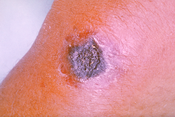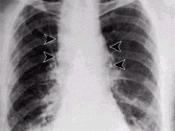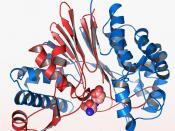Anthrax' in recent times has become very well publicised in this time of uncertainty. With the threat of terrorism lingering, anthrax has been documented in its use as a biological warfare agent. The following will discuss what type of disease anthrax is, the symptoms of infection, what is occurring at the cellular level to cause the symptoms and possible treatments available to counteract anthrax effects.
Anthrax also known as splenic fever, malignant pustule or woolsorter's is a contagious disease of ectodermic animals (including humans) caused by the bacterium Bacillus Anthracis. Bacillus Anthracis can form spores that are highly refractive to light and resistant to staining. There are three types of anthrax: coetaneous ("skin"), gastrointestinal ("stomach") and inhalational.
Coetaneous Anthrax: the most common of the naturally occurring types of anthrax, comes from handling contaminated animal product such as meat, wool, or hides. The spores germinate, vegetative cells multiply, and a characteristic gelatinous edema develops at the site.
This develops into papule within 12-36 hours after infection. Within 2 days a black scab is formed called an eschar. About 5% to 20% of untreated cases can result in death, but death is rare if antibiotic therapy is given.
Gastrointestinal Anthrax: is a very rare disease this point reinstated by the fact that there was no documented case in the USA during the 20th century. Initial signs of infection are nausea, loss of appetite, vomiting and fever. These symptoms are then followed by severe abdominal pain, vomiting blood, and severe diarrhea. Death results in 25% to 60% of cases.
Inhalational Anthrax: Initial symptoms may develop in 1-6 days and resemble those of the common cold or flu: sore throat, mild fever, muscle aches and tiredness. These mild symptoms however can progress very rapidly after a few days and escalate into severe breathing...



Anthrax
Wow this is a very scary subject.
4 out of 5 people found this comment useful.